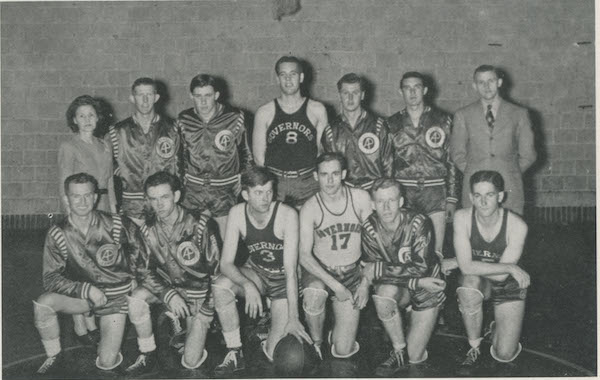APSU remembers Bea Lowe – 1945 men’s basketball coach

CLARKSVILLE, Tenn. – On a cold, winter afternoon in 1945, Bea Lowe, a “super-dynamic little redhead,” stepped quickly into a gymnasium on the Austin Peay State College campus. Everyone in that small, sweaty-smelling building recognized her as the girls’ physical education instructor, but on this particular day, she headed straight for a group of lanky young men.
The boys, standing casually next to the bleachers, probably surrounded the popular teacher, excitedly telling her that Austin Peay was reinstating its men’s basketball program. World War II had put intercollegiate sports on hold for the last two years, but the Governors would soon return to the hardwood courts. All they needed was a new coach.
“Bea Lowe, a professor at Austin Peay, agreed to take control of the men’s team in 1945 and is still remembered as the only female head coach of an all-men’s team,” Charles M. Waters wrote in his book, “The First Fifty Years of Austin Peay State University.”
Seventy-eight years later, Lowe’s name is hardly ever mentioned around campus – her historic accomplishment hidden away in old yearbooks and yellowed clippings from The All-State, Austin Peay’s student-run newspaper. But with today, March 8, designated as International Women’s Day – “a global day celebrating the social, economic, cultural, and political achievements of women,” according to its website – the University is honoring this athletics pioneer by reviving her forgotten story.
Super-dynamic little redhead

Lowe arrived at Austin Peay in 1941 as the “Instructor of Physical Education for Girls.” Her husband, Dr. Marvin Lowe, was chair of the college’s history department, but the students were more impressed by “Mrs. Lowe,” who had trained in Denmark, graduated from Colorado State College and taught at Shurtleff College in Illinois.
According to a 1943 article in The All State, Lowe was a “super-dynamic little redhead with personality plus (the plus is for the love of the students) who dashes around school happily calling herself Mrs. Dr.”
Having studied recreation and exercise in Europe, she transformed Austin Peay’s physical education department, The All State reported, by introducing students to strange equipment, like a “Soccer Ball, Shuffle Board, Badminton complete with two nets and other equipment, volley ball, basketball, paddle tennis, field ball, pateca, indoor horseshoes, indoor bowling, darts, table tennis…”
Lowes’ arrival at Austin Peay coincided with the early years of World War II when most of the college’s male students headed off to fight. Then, in 1943, the War Department sent hundreds of naval cadets to Austin Peay for training. An obstacle course was set up on the football field, and one afternoon, Lowe took her female students through the same arduous military training.
“The other day I peered timidly out of my mole hole on the ‘football’ field and to my surprise I encountered a most engaging even if astonishing sight,” The All State reported. “Girls running the Naval Cadets’ obstacle course…However, after a bit of conversation with a few of my earthly friends, I discovered that Mrs. Lowe was just beginning the year’s physical education program with a bang.”
The return of the Govs
In 1945, with the war winding down across Europe and Asia, the Allies put everything they had into a lasting victory. That meant, as the home front slowly tried to revive a pre-war sense of normalcy with the return of competitive sports, only a few qualified men remained in the U.S. to oversee these young teams.
In “A History of Austin Peay State University: 1806-2002,” Drs. Richard Gildrie and Howard Winn wrote that “gender roles were being altered in many respects during the war. The absence of male instructors and athletics coaches resulted in the frequent suspension of intercollegiate athletic competition.”
In 1945, it was almost unthinkable for a woman to lead a men’s college basketball team, but that’s exactly what happened at Austin Peay when Lowe became head coach of the Governors. She led her young team to a couple of victories, but more importantly, according to Gildrie and Winn, she “surely made history as the female head coach of an all-male basketball team.”